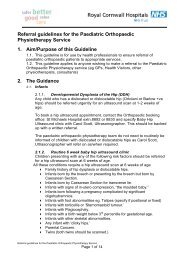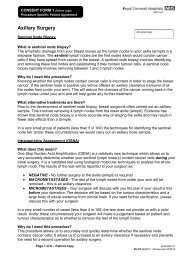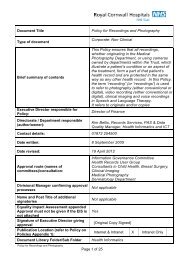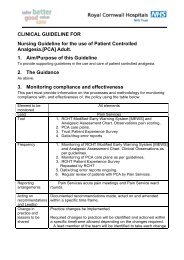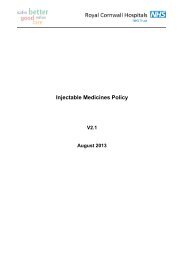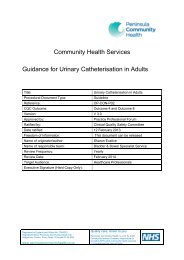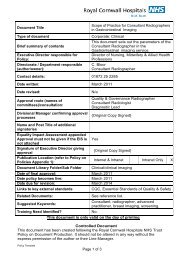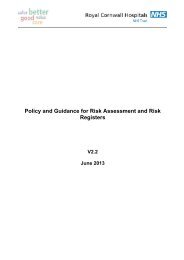Policy for the Discharge and transfer of children and young people ...
Policy for the Discharge and transfer of children and young people ...
Policy for the Discharge and transfer of children and young people ...
You also want an ePaper? Increase the reach of your titles
YUMPU automatically turns print PDFs into web optimized ePapers that Google loves.
• Must in<strong>for</strong>m <strong>the</strong> GP at <strong>the</strong> earliest opportunity <strong>of</strong> any child/<strong>young</strong> person whose carertakes his or her discharge against medical advice.5.4. The Consultant along with o<strong>the</strong>r relevant team members will be notified if a parenttakes home a child/<strong>young</strong> person against medical advice <strong>and</strong> will advise as to whe<strong>the</strong>r <strong>the</strong>child/<strong>young</strong> person would be classed as ‘at risk <strong>of</strong> significant harm’.5.5. When necessary Social Services <strong>and</strong> <strong>the</strong> Police can be contacted to enable <strong>the</strong>child/<strong>young</strong> person to be returned to hospital. Please refer to Appendix 5 <strong>for</strong> <strong>the</strong> Self-<strong>Discharge</strong> Pathway.• Must ensure, that, whenever possible, discharge prescriptions are completed inadvance, to allow adequate time <strong>for</strong> <strong>the</strong> dispensing <strong>of</strong> medicines <strong>and</strong> <strong>the</strong> provision <strong>of</strong>in<strong>for</strong>mation to <strong>the</strong> child/<strong>young</strong> person <strong>and</strong> carer.• Must liaise with relevant o<strong>the</strong>r providers when a <strong>transfer</strong> is required to ensureacceptance <strong>of</strong> <strong>the</strong> <strong>transfer</strong> <strong>and</strong> to agree any necessary arrangements.• When a decision has been made to <strong>transfer</strong>, <strong>the</strong> consultant or senior doctor willensure that <strong>the</strong> receiving service has a full written account <strong>of</strong> care delivered withinRCHT stating clearly <strong>the</strong> reasons <strong>for</strong> <strong>transfer</strong>. This must be discussed fully with <strong>the</strong>parents/carers <strong>and</strong> whenever possible with <strong>the</strong> child or <strong>young</strong> person.5.6. Role <strong>of</strong> Nursing StaffNursing Staff involved in <strong>the</strong> discharge/<strong>transfer</strong> <strong>of</strong> <strong>children</strong> or <strong>young</strong> <strong>people</strong>:• Should collect <strong>and</strong> clearly document accurate in<strong>for</strong>mation relating to <strong>the</strong> child/<strong>young</strong>person’s individual social circumstances as soon as possible followingadmission/service contact. This in<strong>for</strong>mation will <strong>for</strong>m <strong>the</strong> basis <strong>of</strong> <strong>the</strong>ir dischargeplanning arrangements <strong>and</strong> will be included in any <strong>transfer</strong> documentation.• Should discuss all babies under a year <strong>of</strong> age with <strong>the</strong> health visitor /midwife withreference to <strong>the</strong> vulnerability criteria (Appendix 4) as applicable, <strong>and</strong> ensure thisdiscussion is documented. The Paediatric <strong>Discharge</strong>/Liaison Co-Ordinator can becontacted <strong>for</strong> fur<strong>the</strong>r advice <strong>and</strong> support.• Should assess <strong>children</strong>/<strong>young</strong> <strong>people</strong> against <strong>the</strong> vulnerability criteria (Appendix 4),<strong>and</strong> where a child/<strong>young</strong> person is identified as ‘vulnerable’ discuss <strong>the</strong>m with <strong>the</strong>Health Visitor/School Nurse <strong>and</strong> ensure this discussion is documented. ThePaediatric <strong>Discharge</strong>/Liaison Co-Ordinator can be contacted <strong>for</strong> fur<strong>the</strong>r advice <strong>and</strong>support.• Identify any specialist medical equipment or support required along with <strong>the</strong> multidisciplinary team <strong>and</strong> in<strong>for</strong>m Community Nurse, Midwife, Health Visitor or SchoolNurse to allow <strong>for</strong> equipment to be in place at time <strong>of</strong> discharge.• Will provide written in<strong>for</strong>mation concerning discharge in <strong>the</strong> <strong>for</strong>m <strong>of</strong> <strong>the</strong> Paediatric<strong>Discharge</strong> Leaflet – Going Home – Preparing <strong>for</strong> your Child’s <strong>Discharge</strong> fromHospital.<strong>Policy</strong> <strong>for</strong> <strong>the</strong> discharge <strong>and</strong> <strong>transfer</strong> <strong>of</strong> <strong>children</strong> <strong>and</strong> <strong>young</strong> <strong>people</strong> from child healthPage 5 <strong>of</strong> 38
• Will ensure that a discharge summary is sent to <strong>the</strong> <strong>children</strong>/<strong>young</strong> <strong>people</strong>’s healthvisitor/ school nurse. This should be within 24 hours <strong>of</strong> discharge. Parents can begiven a copy, if available, prior to <strong>the</strong>m leaving <strong>the</strong> ward.• Have a responsibility, in consultation with medical staff <strong>for</strong> co-ordinating whichmultidisciplinary team members <strong>and</strong> agencies need to be involved in <strong>the</strong> assessment<strong>and</strong> discharge/<strong>transfer</strong> plan <strong>for</strong> <strong>the</strong> <strong>children</strong>/<strong>young</strong> <strong>people</strong>. If <strong>the</strong> child has nursingneeds, <strong>the</strong> Children’s Community Nurses should be notified as soon as possiblefollowing admission via a Paediatric Community Nursing referral <strong>for</strong>m (Appendix 6 &7). All members <strong>of</strong> <strong>the</strong> multidisciplinary team involved in <strong>the</strong> child or <strong>young</strong> personscare must also be made aware <strong>of</strong> any <strong>transfer</strong>.• Have a responsibility <strong>for</strong> ensuring that <strong>the</strong> relevant community nurse/healthvisitor/school nurse is invited to attend any multidisciplinary meetings regardingdischarge or <strong>transfer</strong>. Adequate notice <strong>of</strong> such meeting must be given wheneverpossible. The Paediatric <strong>Discharge</strong>/Liaison Co-Ordinator can be contacted <strong>for</strong> fur<strong>the</strong>radvice <strong>and</strong> support.• Will ensure that <strong>transfer</strong>s <strong>of</strong> <strong>children</strong>/<strong>young</strong> <strong>people</strong> to o<strong>the</strong>r provider units from acutepaediatric services use <strong>the</strong> same st<strong>and</strong>ards as discharges, <strong>and</strong> that <strong>the</strong> <strong>transfer</strong>documentation (appendix 8) is completed, transport is arranged <strong>and</strong> personalproperty <strong>and</strong> <strong>the</strong> relevant medical records are <strong>transfer</strong>red with <strong>the</strong> child/<strong>young</strong>person.• Will co-ordinate transport arrangements at <strong>the</strong> earliest opportunity to ensure that <strong>the</strong>timing takes account <strong>of</strong> <strong>the</strong> care arrangements made <strong>for</strong> <strong>the</strong> day <strong>of</strong> discharge. Whentransport is required <strong>for</strong> <strong>transfer</strong> this will also be arranged by <strong>the</strong> nursing staff whomust at all times liaise with Patient Transport Services (PTS) ensuring a riskassessment is carried out when considering mode <strong>of</strong> transport• Should ensure that <strong>the</strong> <strong>children</strong>/<strong>young</strong> <strong>people</strong>’s carers are involved in assessments<strong>and</strong> discharge or <strong>transfer</strong> plans. Their views should be sought, recorded <strong>and</strong>communicated with o<strong>the</strong>r members <strong>of</strong> <strong>the</strong> multidisciplinary team.• Will ensure that, if necessary, <strong>the</strong> community nursing services have full written details<strong>of</strong> nursing requirements, equipment <strong>and</strong> disposable supplies required <strong>for</strong> discharge<strong>and</strong> continuing care at home by helping <strong>the</strong>m to complete <strong>the</strong>ir nursing assessmentdocumentation. This may be part <strong>of</strong> <strong>the</strong> agreed discharge plan or a copy <strong>of</strong> <strong>the</strong>discharge summary.• Should ensure that <strong>children</strong>/<strong>young</strong> <strong>people</strong> <strong>and</strong> carers are given relevant in<strong>for</strong>mation,verbally <strong>and</strong> in writing, regarding medication, follow up services, health education<strong>and</strong> where to get help if needed. The guidance <strong>for</strong> Open Access to <strong>the</strong> PaediatricWards (Child Health Website -May 2009) should be followed <strong>for</strong> those who mayrequire this facility.• Should ensure child/<strong>young</strong> person is discharged from PAS5.7. Role <strong>of</strong> Paediatric <strong>Discharge</strong> Liaison5.8. Whilst responsibility <strong>for</strong> managing discharge remains with <strong>the</strong> ward, <strong>the</strong> Paediatric<strong>Discharge</strong>/Liaison Co-Ordinator will provide assistance/support, where appropriate, in<strong>Policy</strong> <strong>for</strong> <strong>the</strong> discharge <strong>and</strong> <strong>transfer</strong> <strong>of</strong> <strong>children</strong> <strong>and</strong> <strong>young</strong> <strong>people</strong> from child healthPage 6 <strong>of</strong> 38
elation to communication between hospital <strong>and</strong> community services. The Paediatric<strong>Discharge</strong>/Liaison Co-Ordinator pathways are detailed in Appendix 9.6. St<strong>and</strong>ards <strong>and</strong> Practice6.1. <strong>Discharge</strong> <strong>of</strong> Children/Young People without continuing healthcareneed6.2. When <strong>the</strong> hospital admission has been straight<strong>for</strong>ward, discharge planningneed not be elaborate, but must include:• Written in<strong>for</strong>mation to <strong>the</strong> GP <strong>and</strong> Health Visitor/Midwife (under 5’s) <strong>and</strong> School• Nurse (over 5’s). All parents <strong>and</strong> carers must be in<strong>for</strong>med <strong>of</strong> this sharing <strong>of</strong>in<strong>for</strong>mation <strong>and</strong> <strong>the</strong>y must be given <strong>the</strong> opportunity to let us know if <strong>the</strong>y do not wishthis to happen. This in<strong>for</strong>mation must be copied to <strong>the</strong> parents <strong>and</strong>/or <strong>young</strong> person• Enter record <strong>of</strong> admission in parent held record including height <strong>and</strong> weight.• Appropriate in<strong>for</strong>mation, in writing, where available <strong>for</strong> <strong>the</strong> parents/<strong>young</strong> personabout any likely after effects <strong>and</strong> follow on treatment• Provision <strong>of</strong> written in<strong>for</strong>mation to parents/carers about medication, including safestorage <strong>and</strong> side effects. The instructions/advice on <strong>the</strong> discharge summary isacceptable, as are patient in<strong>for</strong>mation leaflets.• What to do should <strong>the</strong>ir child/<strong>young</strong> person’s condition deteriorate.• Written point <strong>of</strong> contact in case <strong>of</strong> difficulty.• Written arrangements <strong>for</strong> follow up.• Written <strong>and</strong> verbal health promotion/illness prevention advice.• Whenever <strong>the</strong>re is in<strong>for</strong>mation sharing or verbal consent, details should bedocumented in <strong>the</strong> health record• <strong>Discharge</strong> Plan <strong>and</strong> Checklist (Appendix 3) is completed <strong>and</strong> filed in <strong>the</strong> child’snotes.• <strong>Discharge</strong> from PAS6.3. <strong>Discharge</strong> <strong>of</strong> Children/Young <strong>people</strong> with Complex <strong>and</strong> On-goingHealthcare Requirements6.4. Where <strong>the</strong>re is a more complex hospital episode <strong>and</strong>/or <strong>the</strong> child has ongoinghealthcare needs (e.g. long term illness, disability or life limiting conditions) discharge or<strong>transfer</strong> planning must include all <strong>of</strong> <strong>the</strong> above <strong>and</strong>, appropriate consideration must begiven to:• Medical in<strong>for</strong>mation being sought from <strong>the</strong> previous NHS Trust(s) be<strong>for</strong>e dischargewhere a child is admitted to hospital with an ongoing medical problem. (To includein<strong>for</strong>mation about any social or child protection concerns).• Social Services contact <strong>and</strong> follow up arrangements.• Primary Care contact <strong>and</strong> follow up arrangements.• Community Children’s Nursing / Allied Health Pr<strong>of</strong>essional contact <strong>and</strong> follow uparrangements - <strong>the</strong> ward needs to be aware <strong>of</strong> <strong>the</strong> roles <strong>of</strong> <strong>the</strong>se groups, <strong>the</strong>ir referralprocesses <strong>and</strong> <strong>the</strong> in<strong>for</strong>mation <strong>the</strong>y will require, prior to discharge, to support <strong>children</strong>who are discharged with additional needs.• Community Paediatric contact details <strong>and</strong> follow up• On-going hospital contact <strong>and</strong> follow up arrangements• Equipment needs.• Parent/Carer’s pr<strong>of</strong>iciency in managing <strong>the</strong>ir child’s condition <strong>and</strong> associated needs<strong>Policy</strong> <strong>for</strong> <strong>the</strong> discharge <strong>and</strong> <strong>transfer</strong> <strong>of</strong> <strong>children</strong> <strong>and</strong> <strong>young</strong> <strong>people</strong> from child healthPage 7 <strong>of</strong> 38
6.5. A discharge planning meeting should be provisionally booked within 24-48 hours <strong>of</strong>admission <strong>for</strong> those <strong>children</strong> with complex needs whose discharge may not bestraight<strong>for</strong>ward.6.6. It is <strong>the</strong> responsibility <strong>of</strong> <strong>the</strong> hospital nursing staff in consultation with <strong>the</strong> medicalstaff to coordinate which multi-agency teams need to be involved in <strong>the</strong> assessment <strong>and</strong>discharge or <strong>transfer</strong> <strong>of</strong> <strong>children</strong> <strong>and</strong> <strong>young</strong> <strong>people</strong>. Due to <strong>the</strong> complexity <strong>of</strong> some <strong>of</strong> <strong>the</strong>sedischarge or <strong>transfer</strong> arrangements <strong>the</strong>re must be a named person, known to <strong>the</strong> child <strong>and</strong>family, who will co-ordinate ongoing care. This person will act as <strong>the</strong> single point <strong>of</strong> contactshould <strong>the</strong> family experience difficulty with ongoing care arrangements. This person canbe identified via <strong>the</strong> common assessment framework process.6.7. The Paediatric <strong>Discharge</strong>/Liaison Co-Ordinator can be contacted <strong>for</strong> fur<strong>the</strong>r advice<strong>and</strong> support with this process.6.8. Ward staff should ensure that parent’s/carer’s are adequately trained in <strong>the</strong> care <strong>of</strong><strong>the</strong>ir child be<strong>for</strong>e discharge. This applies to <strong>the</strong> administration <strong>of</strong> medicine, in addition to<strong>the</strong> management <strong>of</strong> any equipment.6.9. <strong>Discharge</strong> <strong>of</strong> Children <strong>and</strong> Young People in Special CircumstancesChild Protection Concerns• Where <strong>the</strong>re are concerns about possible child protection issues, <strong>the</strong>re mustbe a multi-agency action plan agreed <strong>and</strong> recorded be<strong>for</strong>e <strong>the</strong> child leaves hospital.• Any legal orders arising from <strong>the</strong> admission should be recorded (with copies filed ifavailable)• The child must be registered with a GP be<strong>for</strong>e discharge• No child can be discharged or <strong>transfer</strong>red from hospital, where <strong>the</strong>re are childprotection concerns without <strong>the</strong> permission <strong>of</strong> <strong>the</strong> responsible ConsultantPaediatrician. This can only be given once a clear, agreed action plan is in place <strong>and</strong>confirmation that <strong>the</strong> child is being discharged/<strong>transfer</strong>red to a place <strong>of</strong> safety.• So far as possible, all investigations should be completed be<strong>for</strong>e discharge/<strong>transfer</strong>,even if <strong>the</strong> child is deemed medically fit, with clearly documented plans in place <strong>for</strong>any remaining/follow up investigations.• Medical in<strong>for</strong>mation should be sought from <strong>the</strong> previous NHS Trust(s) be<strong>for</strong>edischarge where a child admitted to hospital with an ongoing medical problem, or isrecognized as at risk <strong>of</strong> harm, has already been treated at ano<strong>the</strong>r hospital.• All follow-up plans, <strong>for</strong> all agencies, must be clearly documented <strong>and</strong> confirmed.• If <strong>the</strong> child is discharged to an address o<strong>the</strong>r than <strong>the</strong>ir home address <strong>and</strong>/or into <strong>the</strong>care <strong>of</strong> someone o<strong>the</strong>r than <strong>the</strong>ir parent, this must be clearly recorded in <strong>the</strong> healthrecord, taking care with regard to confidentiality• Whenever possible <strong>the</strong> child, parents/carers should be in<strong>for</strong>med <strong>of</strong> all arrangementsmade, whilst taking care with regard to confidentiality.• The Named Nurse <strong>for</strong> child protection, can be contacted <strong>for</strong> fur<strong>the</strong>r advice via RCHTswitchboard in working hours.• The Multi Agency Referral Unit (MARU) can be contacted in <strong>of</strong>fice hours on 030012311166.10. If <strong>the</strong>re are urgent concerns out <strong>of</strong> <strong>of</strong>fice hours, ei<strong>the</strong>r contact <strong>the</strong> duty doctor <strong>for</strong> childprotection (via RCHT switchboard) or <strong>the</strong> on call social worker (via 01208 251300)6.11. Transition to Adult Services<strong>Policy</strong> <strong>for</strong> <strong>the</strong> discharge <strong>and</strong> <strong>transfer</strong> <strong>of</strong> <strong>children</strong> <strong>and</strong> <strong>young</strong> <strong>people</strong> from child healthPage 8 <strong>of</strong> 38
When a <strong>young</strong> person has ongoing care needs, <strong>and</strong> is reaching <strong>the</strong> age where adultservices will be assuming responsibility <strong>for</strong> this, <strong>the</strong> transition <strong>of</strong> care should be recorded in<strong>the</strong> notes. A named person known to <strong>the</strong> <strong>young</strong> person <strong>and</strong> <strong>the</strong>ir family should beidentified where possible <strong>for</strong> contact in case <strong>of</strong> difficulty.6.12. Children who have remained in hospital <strong>for</strong> 3 months or longerThese <strong>children</strong> will be subject to Section 85 <strong>of</strong> <strong>the</strong> Children Act 2004. The Trust has aresponsibility to notify social services in <strong>the</strong>se circumstances <strong>and</strong> when <strong>the</strong> child isdischarged or <strong>transfer</strong>red to ano<strong>the</strong>r health provider. Please refer to multi agency guidancere <strong>children</strong> who are in hospital <strong>for</strong> more than three months as directed by namedpr<strong>of</strong>essionals <strong>for</strong> child protection.6.13. Palliative care needsChildren who have palliative care needs must have an identified key-worker to co-ordinatean appropriate support network within <strong>the</strong> home setting. They require a written plan <strong>of</strong>treatment <strong>and</strong> intervention, details <strong>of</strong> which have been agreed with <strong>the</strong> family <strong>and</strong> sharedwith <strong>the</strong> community teams prior to discharge.6.14. <strong>Discharge</strong> <strong>of</strong> Infants from <strong>the</strong> Neonatal Unit (NNU)The previous st<strong>and</strong>ards all apply to infants being discharged from NNU who may alsohave a co-ordinated programme <strong>of</strong> follow up, with special arrangements <strong>for</strong> vision,hearing, developmental progress <strong>and</strong> ongoing support. All <strong>of</strong> this should be recorded in <strong>the</strong>child’s notes. The principles <strong>of</strong> <strong>children</strong> with continuing healthcare need outlined above islikely to apply to this group <strong>of</strong> patients.6.15. <strong>Discharge</strong> <strong>of</strong> Children <strong>and</strong> Young <strong>people</strong> with Mental HealthIssuesWhere a child has an identified mental health need, arrangements must be made in <strong>the</strong>discharge or <strong>transfer</strong> plan <strong>for</strong> follow up from <strong>the</strong> Child <strong>and</strong> Adolescent Mental HealthService (CAMHS). Where this is not thought to be necessary <strong>the</strong> reason(s) <strong>for</strong> thisdecision need to be agreed with <strong>the</strong> child/<strong>young</strong> person’s consultant <strong>and</strong> documented in<strong>the</strong> health record.6.16. <strong>Discharge</strong> from <strong>the</strong> Emergency Department6.17. Many <strong>children</strong> will be seen <strong>and</strong> assessed in <strong>the</strong> Emergency Department <strong>and</strong> deemedmedically fit <strong>for</strong> discharge during <strong>the</strong> working day, evenings, weekends or bank holidays.For most <strong>children</strong> this can occur safely <strong>and</strong> without concern <strong>for</strong> <strong>the</strong> social circumstances.6.18. The clinical staff discharging <strong>the</strong> patient must ensure that, in addition to a full medicalassessment, <strong>the</strong>y make & document an assessment <strong>of</strong> <strong>the</strong> social circumstances <strong>and</strong>consider if <strong>the</strong> child <strong>and</strong> <strong>the</strong>ir accompanying carers can safely return home. If <strong>the</strong>re is anyconcern that <strong>the</strong> child may not be able to return home safely <strong>and</strong> in a timely way,consideration should be made <strong>of</strong> provision <strong>of</strong> hospital transport or admission to childhealth until such time that public transport is easily accessible.6.19. Where a child <strong>and</strong> <strong>the</strong>ir parent/carer have arrived by ambulance <strong>and</strong> are deemedmedically fit <strong>for</strong> discharge, it is <strong>the</strong> parent/carers responsibility to arrange transport home.If <strong>the</strong> discharge is to occur during unsocial hours parents/carers should still try <strong>and</strong> arrangetransport home. In exceptional circumstances where this may not be possible <strong>and</strong>parents/carers have exhausted all avenues, fur<strong>the</strong>r advice can be sought from Child<strong>Policy</strong> <strong>for</strong> <strong>the</strong> discharge <strong>and</strong> <strong>transfer</strong> <strong>of</strong> <strong>children</strong> <strong>and</strong> <strong>young</strong> <strong>people</strong> from child healthPage 9 <strong>of</strong> 38
Health, specifically in relation to <strong>the</strong> availability <strong>of</strong> <strong>the</strong> Macdonald Suite Familyaccommodation.6.20. A discharge summary should be sent to <strong>the</strong> GP.6.21. The Health Visitor/Midwife (under 5’s) <strong>and</strong> School nurse (over 5’s) should be notified<strong>of</strong> <strong>the</strong> attendance.6.22. Transfer <strong>of</strong> Children <strong>and</strong> Young People• When <strong>children</strong>/<strong>young</strong> <strong>people</strong> are being <strong>transfer</strong>red within <strong>the</strong> hospital details <strong>of</strong> <strong>the</strong><strong>transfer</strong> should be documented in <strong>the</strong> health record.• When <strong>children</strong>/<strong>young</strong> <strong>people</strong> are <strong>transfer</strong>red to ano<strong>the</strong>r provider <strong>the</strong> <strong>transfer</strong>document (appendix 8) should be completed <strong>and</strong> <strong>the</strong> Patients Transport Service(PTS) at RCHT should be consulted to book appropriate transport.• Out <strong>of</strong> hours <strong>transfer</strong>s should be minimal <strong>and</strong> based on risk assessment <strong>of</strong> <strong>the</strong>clinical situation as outlined in RCHT Guideline <strong>for</strong> Critical Care Transfers.Arrangements <strong>for</strong> this type <strong>of</strong> <strong>transfer</strong> will be made with SWAST directly <strong>and</strong> <strong>the</strong>RCHT site co-ordinator notified.• The personnel who accompany <strong>the</strong> child /<strong>young</strong> person will be decided by seniorclinical staff based on clinical need <strong>and</strong> staff availability – this will be documented in<strong>the</strong> health record or on <strong>the</strong> <strong>transfer</strong> document. Clinical assessment should be done inline with RCHT <strong>Policy</strong> <strong>for</strong> Observation <strong>and</strong> Monitoring in Child Health <strong>and</strong> recordedon <strong>the</strong> patient records <strong>for</strong> intra hospital <strong>transfer</strong>s <strong>and</strong> on <strong>the</strong> <strong>transfer</strong> document ifbeing <strong>transfer</strong>red to ano<strong>the</strong>r provider.6.23. <strong>Discharge</strong> involving Children <strong>and</strong> Young People from The Isles <strong>of</strong>Scilly (IoS)• When planning a discharge/<strong>transfer</strong> to <strong>the</strong> IoS due regard must be given to <strong>the</strong>additional time needed to reach <strong>the</strong> Isl<strong>and</strong>s because <strong>of</strong> <strong>the</strong> limited transport servicesavailable, particularly at weekends. In addition consideration should also be given to<strong>transfer</strong> times involved if onward transport by boat from St. Mary’s is required when<strong>the</strong> child/<strong>young</strong> person lives on an <strong>of</strong>f-isl<strong>and</strong>.• It will need to be confirmed that <strong>the</strong> child/<strong>young</strong> person is medically fit to travel to <strong>the</strong>airport, <strong>and</strong> onward by air.• If <strong>the</strong> family have a return ticket nursing staff will provide assistance/advice, ifnecessary, about how to book a flight.• If <strong>the</strong> family do not have a return ticket it will be necessary <strong>for</strong> <strong>the</strong>m to contact <strong>the</strong>Patient Transport Service Office (PTS) on 01872 252211 to request a travel warrantto return to <strong>the</strong> Isles <strong>of</strong> Scilly <strong>and</strong> to arrange a flight.• Nursing staff will provide families with in<strong>for</strong>mation regarding transport to <strong>the</strong> airport.• Where a child <strong>and</strong> <strong>the</strong>ir parent/carer have arrived by ambulance <strong>and</strong> are deemedmedically fit <strong>for</strong> discharge, it is <strong>the</strong> parent/carers responsibility to arrange transporthome. If <strong>the</strong> discharge is to occur during unsocial hours fur<strong>the</strong>r advice can be soughtfrom Child Health, specifically in relation to <strong>the</strong> availability <strong>of</strong> <strong>the</strong> Macdonald SuiteFamily accommodation.7. Dissemination <strong>and</strong> Implementation7.1. Ward <strong>and</strong> Department Managers are responsible <strong>for</strong> ensuring adequatedissemination <strong>and</strong> implementation <strong>of</strong> <strong>the</strong> policy within <strong>the</strong>ir own areas.<strong>Policy</strong> <strong>for</strong> <strong>the</strong> discharge <strong>and</strong> <strong>transfer</strong> <strong>of</strong> <strong>children</strong> <strong>and</strong> <strong>young</strong> <strong>people</strong> from child healthPage 10 <strong>of</strong> 38
7.2. All managers will be aware <strong>of</strong> <strong>the</strong> contents <strong>of</strong> this policy <strong>and</strong> will ensure that <strong>the</strong>irstaff have read <strong>and</strong> understood <strong>the</strong> procedures <strong>and</strong> processes relating to <strong>the</strong> discharge<strong>and</strong> <strong>transfer</strong> <strong>of</strong> patients. New versions <strong>of</strong> <strong>the</strong> policy will be circulated to all managers <strong>for</strong>dissemination to <strong>the</strong>ir staff with a summary <strong>of</strong> all amendments made to <strong>the</strong> updatedversion.8. Monitoring compliance <strong>and</strong> effectivenessElement to bemonitoredLeadToolFrequencyReportingarrangementsActing onrecommendations<strong>and</strong> Lead(s)Change inpractice <strong>and</strong>lessons to besharedCompletion <strong>of</strong> a discharge planDocumentation <strong>of</strong> liaison with o<strong>the</strong>r pr<strong>of</strong>essionals <strong>and</strong> agenciesTimeliness <strong>of</strong> documentation to o<strong>the</strong>r pr<strong>of</strong>essionalsCompletion <strong>of</strong> a <strong>transfer</strong> documentDocumentation <strong>of</strong> details <strong>of</strong> <strong>transfer</strong> in patient notesSenior Matron Child HealthAn agreed audit tool developed by <strong>the</strong> Directorate <strong>and</strong> registeredwith clinical effectiveness as part <strong>of</strong> <strong>the</strong> annual records audit, toinclude <strong>the</strong> elements to be monitored described aboveMonthly quality audits will monitor <strong>the</strong> completion <strong>of</strong> discharge plansAnnually <strong>for</strong> <strong>the</strong> whole policy through audit <strong>of</strong> recordsMonthly <strong>for</strong> ward quality audits on discharge plansAudits will be reported via <strong>the</strong> Divisional Audit <strong>and</strong> Guidelinesmeeting in <strong>the</strong> Directorate. Action plans, incidents <strong>and</strong> complaintsrelated to discharge <strong>and</strong> <strong>transfer</strong> will be brought back to <strong>the</strong>Directorate via Clinical Governance meetings.Reports should be discussed at <strong>the</strong> appropriate Operational BoardReports should be discussed at <strong>the</strong> appropriate Operational Board <strong>and</strong>any high risk areas highlighted <strong>and</strong> action plans developed to addressany gaps identified.Lessons will be shared with all <strong>the</strong> relevant stakeholders bypresentation at Child Health audit <strong>and</strong> guidelines meetings <strong>and</strong> via <strong>the</strong>Child Health risk management newsletter. Following liaison withrelevant stakeholders, any required changes to practice will bediscussed at Directorate Clinical Governance meetings, prior to beingreflected in this policy <strong>and</strong> implemented clinically.9. Updating <strong>and</strong> ReviewThe policy author is responsible <strong>for</strong> ensuring <strong>the</strong> policy is kept up to date, with reviews beingcarried out at least once every 3 years, reflecting changes in legislation where necessary.The author must also ensure <strong>the</strong> policy has been screened to establish if it requires a fullImpact Assessment against <strong>the</strong> Race Relations Amendment Act to ensure no minority groupis discriminated against within <strong>the</strong> document.10. Equality <strong>and</strong> Diversity10.1. This document complies with <strong>the</strong> Royal Cornwall Hospitals NHS Trust serviceEquality <strong>and</strong> Diversity statement.10.2. Equality Impact AssessmentThe Initial Equality Impact Assessment Screening Form is at Appendix 2.<strong>Policy</strong> <strong>for</strong> <strong>the</strong> discharge <strong>and</strong> <strong>transfer</strong> <strong>of</strong> <strong>children</strong> <strong>and</strong> <strong>young</strong> <strong>people</strong> from child healthPage 11 <strong>of</strong> 38
Appendix 1. Governance In<strong>for</strong>mationDocument TitleDate Issued/Approved: January 2014Date Valid From: January 2014Date Valid To: January 2017Directorate / Department responsible(author/owner):Contact details: 01872 252636Brief summary <strong>of</strong> contentsSuggested Keywords:Target AudienceExecutive Director responsible <strong>for</strong><strong>Policy</strong>:<strong>Policy</strong> <strong>for</strong> <strong>the</strong> <strong>Discharge</strong> <strong>and</strong> Transfer <strong>of</strong> Children<strong>and</strong> Young People from Child HealthMary Baulch, Matron Child HealthCaroline Amukasana Paediatric discharge liaisonnurseThis policy states <strong>the</strong> responsibilities <strong>of</strong> <strong>the</strong>multidisciplinary team when discharging or<strong>transfer</strong>ring <strong>children</strong>/<strong>young</strong> <strong>people</strong> from child health.Paediatrics, Children, Young People, Neonates,<strong>Discharge</strong>, Transfer.RCHT PCH CFT KCCGMedical DirectorDate revised: January 2014This document replaces (exact title <strong>of</strong>previous version):Approval route (names <strong>of</strong>committees)/consultation:Divisional Manager confirmingapproval processes<strong>Policy</strong> <strong>for</strong> <strong>the</strong> <strong>Discharge</strong> <strong>and</strong> Transfer <strong>of</strong> Children<strong>and</strong> Young People from Child Health version 3.0Child Health Senior Nurses, ConsultantPaediatricians Child Health, RCHT SitemanagementSheena Wallace, Divisional General ManagerWomen & Children’sName <strong>and</strong> Post Title <strong>of</strong> additionalsignatoriesSignature <strong>of</strong> Executive Director givingapprovalPublication Location (refer to <strong>Policy</strong>on Policies – Approvals <strong>and</strong>Ratification):Document Library Folder/Sub FolderLinks to key external st<strong>and</strong>ardsRelated Documents:none{Original Copy Signed}Internet & Intranet Intranet OnlyPaediatricsCare Quality Commission Outcomes1,2,4,6,7,9,14, <strong>and</strong> 21NHSLA Risk Management St<strong>and</strong>ards 4.9 <strong>and</strong> 4.10Multi Agency Safeguarding Children PoliciesRCHT Adult <strong>Discharge</strong> <strong>Policy</strong>RCHT <strong>Policy</strong> on Clinical Record Keeping<strong>Policy</strong> <strong>for</strong> <strong>the</strong> discharge <strong>and</strong> <strong>transfer</strong> <strong>of</strong> <strong>children</strong> <strong>and</strong> <strong>young</strong> <strong>people</strong> from child healthPage 12 <strong>of</strong> 38
Training Need Identified?Guideline <strong>for</strong> Open Access to <strong>the</strong> PaediatricWards (Child Health website)<strong>Policy</strong> <strong>for</strong> Children who are in Hospital <strong>for</strong>more than three monthsRCHT <strong>Policy</strong> <strong>for</strong> patient observation <strong>and</strong>monitoring in Child HealthClinical policy <strong>for</strong> safe <strong>transfer</strong> <strong>of</strong> patientsbetween care areas or between hospitalsDH: Working Toge<strong>the</strong>r to Safeguard Children2013DH NSF For <strong>children</strong> <strong>young</strong> <strong>people</strong> <strong>and</strong>maternity services (2004)DH: Framework <strong>for</strong> Assessment <strong>of</strong> Children inNeed <strong>and</strong> Their Families 2001Children Act 2004DH: <strong>Discharge</strong> from Hospital, Pathway,Process <strong>and</strong> Practice 2003Reder P. et al (1993) Beyond Blame RoutledgeLONDONReder P. & Duncan S. (1999) Lost InnocenceRoutledge LONDONBrowne K. (1995) in The Child ProtectionH<strong>and</strong>book edited by Wilson & James BalliereTindall LONDONCEMACH (2004) Why Mo<strong>the</strong>rs Die(2000-2002) Report on confidential enquiries intomaternal deaths in <strong>the</strong> United Kingdom,RCOG Press LONDONAppendix 7- original document from CornwallFoundation trustAppendix 8- Original document from regionalcritical care group.No<strong>Policy</strong> <strong>for</strong> <strong>the</strong> discharge <strong>and</strong> <strong>transfer</strong> <strong>of</strong> <strong>children</strong> <strong>and</strong> <strong>young</strong> <strong>people</strong> from child healthPage 13 <strong>of</strong> 38
Version Control TableDateVersionNoMay 09 V1.0Summary <strong>of</strong> ChangesFinal amendments approved;EIA Completed; documentpublishedChanges Made by(Name <strong>and</strong> Job Title)Mary BaulchSenior Matron Child HealthMay 11 V2.0 Full review & consultationMary BaulchSenior Matron Child HealthDec 11 V3.0Rewording <strong>of</strong> <strong>transfer</strong> element toclarify processMary BaulchMatron Child HealthJan 14 V4.0 Full review & consultationCaroline AmukusanaPaediatric Liaison/<strong>Discharge</strong>Co-OrdinatorTabitha Fergus Deputy wardmanger- re <strong>for</strong>matAll or part <strong>of</strong> this document can be released under <strong>the</strong> Freedom <strong>of</strong> In<strong>for</strong>mation Act2000This document is to be retained <strong>for</strong> 10 years from <strong>the</strong> date <strong>of</strong> expiry.This document is only valid on <strong>the</strong> day <strong>of</strong> printingControlled DocumentThis document has been created following <strong>the</strong> Royal Cornwall Hospitals NHS Trust<strong>Policy</strong> on Document Production. It should not be altered in any way without <strong>the</strong> expresspermission <strong>of</strong> <strong>the</strong> author or <strong>the</strong>ir Line Manager.<strong>Policy</strong> <strong>for</strong> <strong>the</strong> discharge <strong>and</strong> <strong>transfer</strong> <strong>of</strong> <strong>children</strong> <strong>and</strong> <strong>young</strong> <strong>people</strong> from child healthPage 14 <strong>of</strong> 38
Appendix 2. Initial Equality Impact Assessment FormName <strong>of</strong> <strong>the</strong> strategy / policy /proposal / service function to be assessed (hereafter referred toas policy) (Provide brief description): <strong>Policy</strong> <strong>for</strong> <strong>the</strong> <strong>Discharge</strong> <strong>and</strong> Transfer <strong>of</strong> Children <strong>and</strong>Young People from Child HealthDirectorate <strong>and</strong> service area:Is this a new or existing <strong>Policy</strong>?Child HealthExistingName <strong>of</strong> individual completingTelephone: 01872 252636assessment:1. <strong>Policy</strong> Aim*Who is <strong>the</strong> strategy /policy / proposal /service functionaimed at?Mary BaulchThis policy has been developed to support Trust Staff in <strong>the</strong>discharge <strong>and</strong> <strong>transfer</strong> <strong>of</strong> <strong>children</strong> <strong>and</strong> <strong>young</strong> <strong>people</strong>. It is arequirement <strong>of</strong> <strong>the</strong> “NSF <strong>for</strong> Children, Young <strong>people</strong> <strong>and</strong> MaternityServices” to have in place a policy that meets <strong>the</strong> specific needs <strong>of</strong>this group.2. <strong>Policy</strong> Objectives* To ensure safe <strong>and</strong> effective discharge <strong>and</strong> <strong>transfer</strong> <strong>of</strong> <strong>children</strong> <strong>and</strong><strong>young</strong> <strong>people</strong> from <strong>the</strong> Child Health Directorate3. <strong>Policy</strong> – intendedOutcomes*4. *How will youmeasure <strong>the</strong>outcome?5. Who is intended tobenefit from <strong>the</strong>policy?6a) Is consultationrequired with <strong>the</strong>work<strong>for</strong>ce, equalitygroups, local interestgroups etc. aroundthis policy?b) If yes, have <strong>the</strong>se*groups beenconsulted?Safe <strong>and</strong> timely discharge <strong>and</strong> <strong>transfer</strong> <strong>of</strong> patientsAnnual audit <strong>of</strong> discharge documentationRCHT Staff <strong>and</strong> PatientsNoN/AC). Please list anygroups who havebeen consulted aboutthis procedure.7. The ImpactPlease complete <strong>the</strong> following table.Are <strong>the</strong>re concerns that <strong>the</strong> policy could have differential impact on:Equality Str<strong>and</strong>s: Yes No Rationale <strong>for</strong> Assessment / Existing EvidenceAge<strong>Policy</strong> <strong>for</strong> <strong>the</strong> discharge <strong>and</strong> <strong>transfer</strong> <strong>of</strong> <strong>children</strong> <strong>and</strong> <strong>young</strong> <strong>people</strong> from child healthPage 15 <strong>of</strong> 38
Sex (male, female, transgender/ genderreassignment)Race / Ethniccommunities /groupsDisability -learningdisability, physicaldisability, sensoryimpairment <strong>and</strong>mental healthproblemsReligion /o<strong>the</strong>r beliefsMarriage <strong>and</strong> civilpartnershipPregnancy <strong>and</strong> maternitySexual Orientation,Bisexual, Gay, heterosexual,LesbianYou will need to continue to a full Equality Impact Assessment if <strong>the</strong> following have beenhighlighted:You have ticked “Yes” in any column above <strong>and</strong>No consultation or evidence <strong>of</strong> <strong>the</strong>re being consultation- this excludes any policieswhich have been identified as not requiring consultation. orMajor service redesign or development8. Please indicate if a full equality analysis is recommended. Yes No 9. If you are not recommending a Full Impact assessment please explain why. No areasrelevantSignature <strong>of</strong> policy developer / lead manager / directorM.Baulch. C.AmukasanaDate <strong>of</strong> completion <strong>and</strong> submission28/11/13Names <strong>and</strong> signatures <strong>of</strong>members carrying out <strong>the</strong>Screening Assessment1.2.Keep one copy <strong>and</strong> send a copy to <strong>the</strong> Human Rights, Equality <strong>and</strong> Inclusion Lead,c/o Royal Cornwall Hospitals NHS Trust, Human Resources Department, Knowledge Spa,Truro, Cornwall, TR1 3HDA summary <strong>of</strong> <strong>the</strong> results will be published on <strong>the</strong> Trust’s web site.Signed _____M.Baulch, C.Amukasana__________Date _____15/01/14___________<strong>Policy</strong> <strong>for</strong> <strong>the</strong> discharge <strong>and</strong> <strong>transfer</strong> <strong>of</strong> <strong>children</strong> <strong>and</strong> <strong>young</strong> <strong>people</strong> from child healthPage 16 <strong>of</strong> 38
Appendix 3. – <strong>Discharge</strong> Plan <strong>and</strong> Checklist- Sample only CHA2690 V4<strong>Policy</strong> <strong>for</strong> <strong>the</strong> discharge <strong>and</strong> <strong>transfer</strong> <strong>of</strong> <strong>children</strong> <strong>and</strong> <strong>young</strong> <strong>people</strong> from child healthPage 17 <strong>of</strong> 38
Sample only CHA2690 V4<strong>Policy</strong> <strong>for</strong> <strong>the</strong> discharge <strong>and</strong> <strong>transfer</strong> <strong>of</strong> <strong>children</strong> <strong>and</strong> <strong>young</strong> <strong>people</strong> from child healthPage 18 <strong>of</strong> 38
Appendix 3a. <strong>Discharge</strong> Checklist <strong>and</strong> Parent Skills-Neonatal Unit. Sample Only CHA3060<strong>Policy</strong> <strong>for</strong> <strong>the</strong> discharge <strong>and</strong> <strong>transfer</strong> <strong>of</strong> <strong>children</strong> <strong>and</strong> <strong>young</strong> <strong>people</strong> from child healthPage 19 <strong>of</strong> 38
<strong>Policy</strong> <strong>for</strong> <strong>the</strong> discharge <strong>and</strong> <strong>transfer</strong> <strong>of</strong> <strong>children</strong> <strong>and</strong> <strong>young</strong> <strong>people</strong> from child healthPage 20 <strong>of</strong> 38
Appendix 4. Vulnerability Criteria1. Poor parenting affecting child’s health or development.2. One or both parents under 21 years.3. Step-parent/co-habitee member <strong>of</strong> household4. Violence within <strong>the</strong> family (includes animals <strong>and</strong> domestic abuse)5. History <strong>of</strong> cruelty- includes child protection categories 1,2,3,4.6. Parents abused/neglected7. Drug/alcohol abuse <strong>of</strong> main carers8. Frequent incidents/injuries9. Behavioural/ emotional vulnerability <strong>of</strong> child10. Unreal expectations <strong>of</strong> child11. Failure to thrive12. Mental illness <strong>of</strong> main carers13. Mo<strong>the</strong>r suffering with post natal depression14. Any o<strong>the</strong>r factor which makes pr<strong>of</strong>essionals instinctively uneasy15. Family closing down to outsiders16. Parents with learning disabilities17. History <strong>of</strong> criminality18. Family isolated within <strong>the</strong> community19. Homelessness20. Late ante natal booking21. Lack <strong>of</strong> engagement with service22. Poor living conditions23. Poor attendance at appointments24. Chaotic lifestyle25. Frequent contact with <strong>the</strong> serviceNB. THE NUMBER OF TICKS NEED NOT INDICATE THE LEVEL OF CONCERN I.E. ONE TICK MAY BE ASSERIOUS AS FOUR.<strong>Policy</strong> <strong>for</strong> <strong>the</strong> discharge <strong>and</strong> <strong>transfer</strong> <strong>of</strong> <strong>children</strong> <strong>and</strong> <strong>young</strong> <strong>people</strong> from child healthPage 21 <strong>of</strong> 38
Appendix 5. Self <strong>Discharge</strong> PathwayIf a parent chooses to take <strong>the</strong> discharge <strong>of</strong> <strong>the</strong>ir child against medical advice, staff shoulddiscuss this with <strong>the</strong> parents, establishing <strong>the</strong>ir reasons <strong>and</strong> explaining <strong>the</strong> risks this could haveon <strong>the</strong>ir child’s health.All discussion should be clearly documented in <strong>the</strong> child’s health record.If <strong>the</strong> parent still requests discharge, <strong>the</strong> appropriate doctor must be contacted immediately inorder to review <strong>the</strong> child <strong>and</strong> fur<strong>the</strong>r in<strong>for</strong>m <strong>and</strong> explain any associated risks to <strong>the</strong> parent.If <strong>the</strong>se interventions fail to deter <strong>the</strong> parent, <strong>the</strong> impact on <strong>the</strong> child’s welfare must be assessedby nursing <strong>and</strong> medical staff, <strong>and</strong> safeguarding procedures should be followed if leaving <strong>the</strong>hospital would place <strong>the</strong> child at significant risk <strong>of</strong> harm.Safeguarding procedures should also be followed if <strong>the</strong> child is subject to a protection plan or isa child in Care.If <strong>the</strong> child is removed against medical advice, <strong>and</strong> <strong>the</strong>re are significant safeguarding concerns,<strong>the</strong> Trust security department should be contacted to assist, <strong>and</strong> an immediate referral toChildren’s Social Care must be made.Staff should not place <strong>the</strong>mselves at risk in trying to prevent <strong>the</strong> parent leaving with <strong>the</strong> child.If <strong>the</strong>re are no safeguarding concerns, <strong>and</strong> <strong>the</strong> child will not be at significant risk <strong>of</strong> harmfollowing discharge, <strong>the</strong> parent should be asked to sign a ‘<strong>Discharge</strong> Against Medical Advice’<strong>for</strong>m.If <strong>the</strong> parent refuses to sign, this must be fully documented in <strong>the</strong> child’s health record.The parent should be advised to contact <strong>the</strong>ir G.P. practice <strong>for</strong> ongoing care.If possible normal discharge procedures should be followed with regard to giving advice,arranging <strong>for</strong> medication etc.Whenever clinically indicated, appropriate outpatient follow-up arrangements should still be<strong>of</strong>fered/made when a child/parent discharges against medical adviceA <strong>young</strong> person assessed as having capacity to underst<strong>and</strong> <strong>the</strong> consequences <strong>of</strong> taking <strong>the</strong>irown discharge against medical advice may wish to take <strong>the</strong>ir own discharge. In this case staffshould try to dissuade <strong>the</strong> patient from doing so.If this is unsuccessful <strong>the</strong> <strong>young</strong> person’s parents must be notified <strong>and</strong> <strong>the</strong> patient should beasked to sign a ‘<strong>Discharge</strong> Against Medical Advice’ <strong>for</strong>m. They should be advised that o<strong>the</strong>rrelevant pr<strong>of</strong>essionals (e.g. G.P., Social Worker, School Nurse) will be in<strong>for</strong>med <strong>of</strong> <strong>the</strong>irdecision.Without exception, <strong>the</strong> child’s GP <strong>and</strong> Health Visitor/School Nurse <strong>and</strong> any o<strong>the</strong>r keypr<strong>of</strong>essionals involved in <strong>the</strong> child’s care must be in<strong>for</strong>med at <strong>the</strong> earliest opportunity, preferablywithin 24 hours, that <strong>the</strong> child has left/been removed from <strong>the</strong> ward.If a parent expresses that <strong>the</strong>y wish to discharge <strong>the</strong>ir child due to a complaint or concern aboutcare, every ef<strong>for</strong>t must be made to address <strong>and</strong> resolve <strong>the</strong> complaint/concern with reference to<strong>the</strong> Trust Complaints’ <strong>Policy</strong>, to enable care to continue<strong>Policy</strong> <strong>for</strong> <strong>the</strong> discharge <strong>and</strong> <strong>transfer</strong> <strong>of</strong> <strong>children</strong> <strong>and</strong> <strong>young</strong> <strong>people</strong> from child healthPage 22 <strong>of</strong> 38
Appendix 6 - Referral Pathway <strong>for</strong> Children’s Community Nurses(CCN) or Diana Nurses (October 2013)Referrals are made to <strong>the</strong> Children’s Community Nurses (CCN) or DianaNurses via <strong>the</strong> CCN/Diana referral <strong>for</strong>mThe referral should be completed electronically on <strong>the</strong> correct referral <strong>for</strong>m, identifying<strong>the</strong> specific input required from <strong>the</strong> CCN/Diana Nursing Service.If <strong>the</strong> referral <strong>for</strong>m is not completed correctly it will not be accepted <strong>and</strong> will be returnedto <strong>the</strong> referrer. (The CCN/Diana team can be contacted prior to referral to discuss)Referral should be emailed toChildrens.services@cornwall.nhs.ukThe CCN/Diana Team may contact referrer to discuss referral <strong>and</strong> to confirmdetails (action time - non-urgent → 10 working days Urgent→ 3 workingdays)Referral will be discussed by <strong>the</strong> team <strong>and</strong> a nurse will be allocated if <strong>the</strong>referral is acceptedReferrer will be notified if referral is not accepted, with reasons why it is notacceptedIf referral is accepted, CCN/Diana Team will contact <strong>the</strong> family to arrange tovisit – Action time - non-urgent – 10 working days Urgent – 3 working daysInitial visit will be a 2 person visit –To identify any potential risks <strong>for</strong> future visitsTo give 2 perspectives when <strong>for</strong>mulating a plan <strong>of</strong> careTo ensure that <strong>the</strong> family are not reliant on a single person <strong>for</strong> futurevisits, advice, etcFollow up will be according to individual need<strong>Discharge</strong> Criteria – If <strong>the</strong>re is no assessed nursing need, or <strong>the</strong> child or<strong>young</strong> person has had no contact or support <strong>for</strong> a period <strong>of</strong> six months<strong>Policy</strong> <strong>for</strong> <strong>the</strong> discharge <strong>and</strong> <strong>transfer</strong> <strong>of</strong> <strong>children</strong> <strong>and</strong> <strong>young</strong> <strong>people</strong> from child healthPage 23 <strong>of</strong> 38
Additional In<strong>for</strong>mation <strong>for</strong> initial visit –In<strong>for</strong>mation that could be given <strong>and</strong> obtained during <strong>the</strong> initial visit if appropriate;What is <strong>the</strong> family expectation <strong>of</strong> <strong>the</strong> Diana Team, what in<strong>for</strong>mation have <strong>the</strong>y beengiven?The Diana Team do not provide long term direct/ h<strong>and</strong>s on careSupporting <strong>and</strong> empowering family to provide care <strong>for</strong> <strong>the</strong>ir childIdentify training needsDiscuss supplies; set up PLUSS, Vygon as necessary.Explain to parents that we will help <strong>the</strong>m to manage <strong>the</strong>ir supplies but it is not ourresponsibility to know when <strong>the</strong>y are running out <strong>and</strong>/or to deliver more at short notice.Help families to underst<strong>and</strong> <strong>the</strong> services <strong>the</strong>y are accessing <strong>and</strong> sign post families too<strong>the</strong>r services as necessaryMulti – disciplinary liaison;In <strong>the</strong> first instance <strong>the</strong> Diana nurse will speak to o<strong>the</strong>r pr<strong>of</strong>essionals, <strong>the</strong>re after it will beup to <strong>the</strong> parents to contact pr<strong>of</strong>essionals as necessary. This will be different during End<strong>of</strong> Life!Discuss psychology involvement – if appropriate Am<strong>and</strong>a could act as <strong>the</strong> second personComplete nursing assessment <strong>and</strong> care plans, wishes document if appropriate-Discuss care packages if necessaryEquipment; what have <strong>the</strong>y got, where did it come from, what do <strong>the</strong>y need, assetnumbers, servicingObtain consent – consider age <strong>and</strong> mental capacityProvide service leafletsRemember some families will be able to absorb more in<strong>for</strong>mation than o<strong>the</strong>rs, a secondassessment visit may be necessary.<strong>Policy</strong> <strong>for</strong> <strong>the</strong> discharge <strong>and</strong> <strong>transfer</strong> <strong>of</strong> <strong>children</strong> <strong>and</strong> <strong>young</strong> <strong>people</strong> from child healthPage 24 <strong>of</strong> 38
Appendix 7 – Children’s Community Nurses/Diana Nurses referral<strong>for</strong>m. Sample only. Forms available from paediatric HDUCommunity Children’s Nursing Team <strong>and</strong> Diana Nursing TeamReferral FormPaediatric Community ServicesC/O Children’s Services Care Management CentreTruro Health ParkInfirmary HillTruroTR1 2JAOut <strong>of</strong> County Patient? Y / N?Tel:Tel: 01872 221400Fax: 01872 246938Financial agreement from referring trust? Y / N?Name <strong>of</strong> Child:Known as:D.O.B.:NHS No:ICS No:Hosp No:Gender:Parent/Guardian:Address:Address <strong>for</strong> visit:Telephone numbers - Home:Mobile:Directions to visit address:<strong>Policy</strong> <strong>for</strong> <strong>the</strong> discharge <strong>and</strong> <strong>transfer</strong> <strong>of</strong> <strong>children</strong> <strong>and</strong> <strong>young</strong> <strong>people</strong> from child healthPage 25 <strong>of</strong> 38
G.P. name / address / telephone number:Diagnosis:Reason <strong>for</strong> visit:Current Medication:<strong>Policy</strong> <strong>for</strong> <strong>the</strong> discharge <strong>and</strong> <strong>transfer</strong> <strong>of</strong> <strong>children</strong> <strong>and</strong> <strong>young</strong> <strong>people</strong> from child healthPage 26 <strong>of</strong> 38
Date first visit requested:Date Visiting County (if applicable):Consultant:O<strong>the</strong>r Pr<strong>of</strong>essionals involved with Family:Additional in<strong>for</strong>mation:<strong>Policy</strong> <strong>for</strong> <strong>the</strong> discharge <strong>and</strong> <strong>transfer</strong> <strong>of</strong> <strong>children</strong> <strong>and</strong> <strong>young</strong> <strong>people</strong> from child healthPage 27 <strong>of</strong> 38
Referrals must be emailed to <strong>the</strong> Care Management Centre:Childrens.services@cornwall.nhs.ukNormally <strong>the</strong> team will need <strong>for</strong>ty eight hours <strong>for</strong> an acute referral <strong>and</strong> five working days <strong>for</strong>o<strong>the</strong>r referrals. We will always be pleased to discuss <strong>the</strong> possibility <strong>of</strong> short notice referrals <strong>and</strong>will respond if we can.Supplies to be provided by referrer:Supplies/equipment requested <strong>for</strong> CCN’s to provide:Name <strong>of</strong> referrer:Date <strong>of</strong> Referral:Date referral sent:Contact Details:<strong>Policy</strong> <strong>for</strong> <strong>the</strong> discharge <strong>and</strong> <strong>transfer</strong> <strong>of</strong> <strong>children</strong> <strong>and</strong> <strong>young</strong> <strong>people</strong> from child healthPage 28 <strong>of</strong> 38
Appendix 8-TRANSFER DOCUMENTSample only. Forms available from paediatric HDUPLEASE AFFIXPATIENT'S ADDRESSOGRAPHPatient's Weight ………………………………………………Date: …………………………………………Time: …………………………………….1. Discussion with receiving unit / Name <strong>of</strong> Staff Member…………………………..………2. H<strong>and</strong>over provided…………………….……..…………………………………………….Mode <strong>of</strong> Transport: 3. Departure time Ambulance Hospital Transport……………….…….……………………………………………………….Para-Medic AmbulanceOwn TransportO<strong>the</strong>r ……………………………………………………………Destination: ………………………………………………………………………………….…Receiving Doctor: ………………………………… Tel. No: ………………………………...Receiving Nurse: ………………………………….. Tel. No: ………………………………...Accompanying Staff / Family:Dr: ……………………………………………………..Nurse: ……………………………………………….…Parent / Carer / O<strong>the</strong>r: …………………………………Contact Details <strong>of</strong> Parent / Carer / O<strong>the</strong>r: …………………………………………………….Current Care Issues:1. ………………………………………………………………2. ………………………………………………………………3. ………………………………………………………………Principle reason <strong>for</strong> <strong>transfer</strong>:<strong>Policy</strong> <strong>for</strong> <strong>the</strong> discharge <strong>and</strong> <strong>transfer</strong> <strong>of</strong> <strong>children</strong> <strong>and</strong> <strong>young</strong> <strong>people</strong> from child healthPage 29 <strong>of</strong> 38
OBSERVATIONSTIMET 39EM 37PC 35333129B 200Pmm 180Hg160140120100R 80ES 60PS 40C 20VP 10mmHg0CRTSp0 2Blood SugarFi0 2/0 2ModeVentilatorRatePressures
PUPILSNEUROOBS:COMASCALEEyesOpenBestMotorResponseBestVerbalResponseRightLeftGlasgow ComaScale (4-15 yrs)Children’s ComaScale (< 4 yrs)Spontaneously 4 Spontaneously 4To Speech 3 To Speech 3To Pain 2 To Pain 2No Response 1 No Response 1Obeys verbal comm<strong>and</strong>s 6 Obeys verbal comm<strong>and</strong>s 6Localises pain 5 Localises pain 5Flexion to pain 4 Withdraws in response 4Abnormal flexion 3 Abnormal flexion 3Extension to pain 2 Abnormal extension 2No Response 1 No Response 1Orientated & converses 5 Smiles, orientated to sounds,follows objects, interactsDisorientated & converse 4 Crying InteractsConsolable InappropriateInappropriate words 3 Inconsistently Moaning 3ConsolableIncomprehensible sounds 2 Inconsolable Irritable 2No Response 1 No Response No Response 1SizeReactionSizeReactionSizeReactionSizeReaction54TIMEEyes closed byswellingUsually <strong>the</strong>best armresponse= CEndotrachealtube ortracheostomy=T+ reacts- no reactionc eyes closedTIMEFLUIDSINTAKEOUTPUTTOTALUrineTOTALBALANCETRANSFER EVALUATION FORMAirway / C-SpineBreathingCirculationFamilyEnvironmentGlucoseDisabilityO<strong>the</strong>r Comments………………………………………………………………………………………………………………………....……………………………………………………………………………………………………………………<strong>Policy</strong> <strong>for</strong> <strong>the</strong> <strong>Discharge</strong> <strong>and</strong> Transfer <strong>of</strong> Children <strong>and</strong> Young People from Child Health………………………Page 31 <strong>of</strong> 38Signed: ………………………………………………………………….. Date:……………………………………………….
TRANSFER CHECK LISTSELF-INFLATING AMBU BAG - INF / PAED / ADULTOXYGEN / AIR CYLINDERSX 2 / X 3 E SIZE ( X 1 WITH VENT VALVE )PORTABLE CYLINDER FROM BEDSPACEPORTABLE SUCTIONAPPROPRIATE SUCTION CATHETERSECG MONITORPOWER PACK AND LEADETCO2 MONITOR APPROPRIATE CABLESTHERMOMETERSYRINGES50ML10ML / 5ML LEURLOCKNORMAL SYRINGES10ML / 5ML / 2ML / 1MLINSULIN SYRINGESGLUCOSE MONITORIV EXTENSION LINES3 WAY TAPS / T-PIECEFACE MASKSNEO / INFANT / CHILD / SML & LGE ADULTSPACE BLANKETDRUG LABELSGREEN TUBINGSCISSORS / FORCEPSNEBULISER SET + TUBINGNG TUBE & LITMUS PAPERSTETHOSCOPEGLOVES 6.0 - 8.5YANKERS X 2GAUZE X 2GUEDAL AIRWAYS SIZES (x1 <strong>of</strong> each):4 / 3 / 2 / 1 / 0 / 00 / 000 SURGISILK 3/0 / SURGICAL BLADES /SUTCHER CUTTERELASTOPLAST / ASSORTED TAPE /PLASTERSGAMGEE / BUBBLE WRAPSYRINGE PUMPSVOLUMETRIC PUMPDRUG BAGINOTROPES / RESUS DRUGSSEDATIONMISCELLANEOUSINTRA-OSSEOUS NEEDLEIV CANNULAS (e.g. Ne<strong>of</strong>lon, Medicut, etc.)ASSORTED IV BUNGS / STERETSBATTERIES (Appropriate <strong>for</strong> equipment)FAMILY - INFORMED / CONSENT / DIRECTIONSCOPIES OF NOTES / X-RAYS / REF. LETTERRESTRAINT IN TRANSPORTACCEPTING HOSPITAL AWARE OF DEPART.STAFF - FOOD & DRINK / MONEY / PHONEARRANGEMENT FOR RETURNING STAFFFOR INTUBATED CHILDRENVENTILATOR LARYNGOSCOPE HANDLES X 2ETT 2.5 - 8.5 UNCUFFED / CUFFEDFLEXIBLE CATHETER MOUNTSTYLET SIZESANGLE PIECE12 X 22.2 X 1 LARYNGOSCOPE BLADES:1 X SHORT STRAIGHTENDOTRACHEAL TAPE1 X LONG STRAIGHT1 X SHORT CURVEDLARYNGOSCOPE BULBS X 2 SPARE1 X LONG CURVEDAQUAGEL X 2MAGILLS:1 SMALL1 LARGEOTHER: …………………………………………………….OTHER: …………………………………………………….<strong>Policy</strong> <strong>for</strong> <strong>the</strong> <strong>Discharge</strong> <strong>and</strong> Transfer <strong>of</strong> Children <strong>and</strong> Young People from Child HealthPage 32 <strong>of</strong> 38
NURSING REFERRAL FORM - TRANSFER OF PATIENTSHomeTo:FromWardWard Tel. No.HospitalHosp. No:Surname:Age:Religion:Forenames:D.O.B.Home Address:<strong>Discharge</strong> Address:Tel. No:Consultant:Social Worker:General Practitioner:Address:Health Visitor (HV):HV In<strong>for</strong>med <strong>of</strong> Transfer: Yes / NoO<strong>the</strong>r:Next <strong>of</strong> Kin:Address:Relationship:Tel. No:Date <strong>of</strong> Admission:Relatives notified <strong>of</strong> Transfer: Yes / NoDate <strong>of</strong> Transfer:Diagnosis <strong>and</strong> Brief Summary <strong>of</strong> Patient's conditionO<strong>the</strong>r Comments (e.g. Allergies, Special Disabilities, Pre-existent Conditions, to include infectious status etc.)<strong>Policy</strong> <strong>for</strong> <strong>the</strong> <strong>Discharge</strong> <strong>and</strong> Transfer <strong>of</strong> Children <strong>and</strong> Young People from Child HealthPage 33 <strong>of</strong> 38
Nursing Requirements (Including special diets, feeding <strong>and</strong> dressings)Drugs <strong>and</strong> MedicinesFamily In<strong>for</strong>mationFollow-up treatments <strong>and</strong> appointmentsDate 1. ……………………………………… Time …………………………… Place ………………………………………………Date 2. ……………………………………… Time …………………………… Place ………………………………………………What arrangements have been made <strong>for</strong> transport? …..………………………………………………………………....Please photocopy <strong>and</strong> keep1 copy in notesSignature …………………………………………………Designation ……………………………………………….Date ……………………………………………………….<strong>Policy</strong> <strong>for</strong> <strong>the</strong> <strong>Discharge</strong> <strong>and</strong> Transfer <strong>of</strong> Children <strong>and</strong> Young People from Child HealthPage 34 <strong>of</strong> 38
Appendix 9 – Paediatric <strong>Discharge</strong> Liaison Co-Ordinator PathwayCommunity pr<strong>of</strong>essionals includeHealth Visitors, School Nurses,Community Therapies, Communitynurses <strong>and</strong> communityPaediatricians… <strong>and</strong> any o<strong>the</strong>rcommunity services involved.PATHWAY FOR CHILDREN’S WARDS (HDU, POLKERRIS, HARLYN, FISTRAL)Attend wards to ga<strong>the</strong>r in<strong>for</strong>mation regarding any new admissions <strong>and</strong> on-going casesConsider priority/complexity <strong>of</strong> presenting casesROUTINE PRESENTATIONe.g – non-complex planned admissions,minor infections/injuries, <strong>children</strong> who will not needadditional support after dischargeRe-assess on regular visits to ward<strong>and</strong> review in <strong>the</strong> event <strong>of</strong> anychangeWhere <strong>the</strong>re is no change<strong>and</strong> <strong>the</strong> presentation remainsroutine, discharge should bestraight<strong>for</strong>ward <strong>and</strong>completed without <strong>the</strong>additional need <strong>for</strong> supportfrom <strong>the</strong> Paediatric<strong>Discharge</strong>/Liaison Co-OrdinatorHealth Visitors <strong>and</strong> School Nursesmay not be in<strong>for</strong>med <strong>of</strong> routine, noncomplexadmissions unless <strong>the</strong>yspecifically request to be in<strong>for</strong>medIn <strong>the</strong> event <strong>of</strong>changes topresentation, followpathway <strong>for</strong> ComplexPresentationSafeguardingconcerns identifiedshould be shared by<strong>the</strong> wards with <strong>the</strong>Named Nurse <strong>for</strong>Safeguarding, <strong>and</strong>relevant policies <strong>and</strong>procedures followedChildren meeting <strong>the</strong> Criteria<strong>for</strong> Outreach will besupported by OutreachNurses – e.g. Respiratory,Oncology, Diabetes, etc.These discharges are likely toproceed without additionalneed <strong>for</strong> supportCOMPLEX PRESENTATIONe.g – long term illness, disability, life limiting conditions, or <strong>children</strong>who will require additional support after dischargeWork with <strong>the</strong> wards to ensure any relevant community pr<strong>of</strong>essionalshave been in<strong>for</strong>med <strong>and</strong> this has been documented in ward notes (<strong>and</strong>by <strong>Discharge</strong>/Liaison Co-Ordinator on Electronic Records when available<strong>and</strong> where appropriate, * <strong>for</strong> community notes ensure that any call isfollowed up with email to add to patient community notes.)* Responsibility <strong>for</strong> contacting relevant pr<strong>of</strong>essionals remains with<strong>the</strong> ward, <strong>and</strong> community pr<strong>of</strong>essionals maintain responsibility <strong>for</strong>communication with <strong>the</strong> ward, unless <strong>the</strong>re are specific, significantcomplications that would benefit from intervention by <strong>the</strong> Paediatric<strong>Discharge</strong>/Liaison Co-OrdinatorIt remains <strong>the</strong> responsibility <strong>of</strong> community pr<strong>of</strong>essionals to attend relevantmeetings – in <strong>the</strong> event <strong>of</strong> significant difficulties attending meetings <strong>the</strong>Paediatric <strong>Discharge</strong>/Liaison Co-Ordinator can attend <strong>and</strong> provide feedbackto <strong>the</strong> communityAfter involvement in <strong>Discharge</strong> Planning Meeting, where appropriate,discharge may be followed with a call to <strong>the</strong> family to ensure that <strong>the</strong>discharge plan is being followed <strong>and</strong> to ensure that <strong>the</strong> family have <strong>the</strong>relevant contact details <strong>for</strong> <strong>the</strong> community teams/pr<strong>of</strong>essionals.A follow up meeting in <strong>the</strong> community may also take place if appropriate.If a child is identified as a Looked After Child it is <strong>the</strong> ward/departments responsibility to in<strong>for</strong>m Child in Care Team <strong>of</strong> admission/discharge. Paediatric <strong>Discharge</strong>/Liaison Co-<strong>Policy</strong> <strong>for</strong> <strong>the</strong> <strong>Discharge</strong> <strong>and</strong> Transfer <strong>of</strong> Children <strong>and</strong> Ordinator Young People can from assist Child with Health this <strong>and</strong> will double check that in<strong>for</strong>mation has been sharedPage 35 <strong>of</strong> 38
LIAISON WITH SERVICES OUT OF COUNTY – (in development)Out <strong>of</strong> county service to be provided with Paediatric <strong>Discharge</strong>/Liaison Co-Ordinator contact details.Paediatric <strong>Discharge</strong>/Liaison Co-Ordinator to attend Children’s Community Nurse Team meetings on a regular basis<strong>and</strong> remain updated from <strong>the</strong> wards in order to ensure awareness <strong>of</strong> any <strong>children</strong> that are receiving treatment out <strong>of</strong>countyIn <strong>the</strong> first instance, it is <strong>the</strong> responsibility <strong>of</strong> <strong>the</strong> ward <strong>transfer</strong>ring/receiving <strong>the</strong> patient from out-<strong>of</strong> county to in<strong>for</strong>m <strong>the</strong>relevant community service, <strong>and</strong> responsibility <strong>for</strong> maintaining communication with <strong>the</strong> ward remains with <strong>the</strong>community staff involved.Paediatric <strong>Discharge</strong>/Liaison Co-Ordinator role is to liaise with community services (<strong>and</strong> RCHT wards wherenecessary) regarding any discharge/<strong>transfer</strong> plans he/she has been in<strong>for</strong>med <strong>of</strong> (ensuring community staff have beenin<strong>for</strong>med <strong>of</strong> any <strong>transfer</strong>s out <strong>of</strong> <strong>and</strong> into Cornwall where appropriate), <strong>and</strong> to intervene as appropriate where specific,significant complications arise in <strong>the</strong> discharge process.Document in ward notes <strong>and</strong> on Electronic Records when available.* For community notes ensure that any call is followed up with email to add to patient community notes whereelectronic recording is not available.If a child is identified as a Looked After Child it is<strong>the</strong> ward/departments responsibility to in<strong>for</strong>mChild in Care Team <strong>of</strong>admission/discharge/<strong>transfer</strong>. Paediatric<strong>Discharge</strong>/Liaison Co-Ordinator can assist withthis <strong>and</strong> will double check that in<strong>for</strong>mation hasbeen sharedAny Safeguarding concerns identified should beshared with <strong>the</strong> Named Nurse <strong>for</strong> Safeguarding,<strong>and</strong> relevant policies <strong>and</strong> procedures followed**Children’s Community Nurses, <strong>for</strong> <strong>the</strong> purpose <strong>of</strong> this pathway, includes <strong>the</strong> Diana Nurses<strong>Policy</strong> <strong>for</strong> <strong>the</strong> <strong>Discharge</strong> <strong>and</strong> Transfer <strong>of</strong> Children <strong>and</strong> Young People from Child HealthPage 36 <strong>of</strong> 38
NEONATALAttend ward regularly to ga<strong>the</strong>r in<strong>for</strong>mation regarding any new <strong>and</strong> on-going cases.Attend weekly ‘Baby in <strong>the</strong> Family’ meetingsInfants meeting <strong>the</strong> Neonatal Outreach Criteriawill have discharges co-ordinated by <strong>the</strong>Neonatal Unit Team.These discharges are likely to proceed without<strong>the</strong> additional need <strong>for</strong> support from <strong>the</strong>Paediatric <strong>Discharge</strong>/Liaison Co-Ordinator.Infants who will not require complex support afterdischarge may not meet <strong>the</strong> criteria <strong>for</strong> <strong>the</strong> OutreachNurses – Paediatric <strong>Discharge</strong>/Liaison Co-Ordinator toprovide any appropriate additional support <strong>for</strong> <strong>the</strong>seinfants as required by <strong>the</strong> ward – i.e. Additional Liaisonwith Health Visitors or any o<strong>the</strong>r relevant pr<strong>of</strong>essionalLiaise with Outreach Nurses, community Nurses <strong>and</strong> <strong>the</strong> ward where infants are <strong>transfer</strong>red fromNeonatal to Polkerris. Following <strong>transfer</strong>, refer to pathway <strong>for</strong> Children’s WardsIf a child becomes identified as aLooked After Child it is <strong>the</strong>ward/departments responsibility toin<strong>for</strong>m Child in Care Team.Paediatric <strong>Discharge</strong>/Liaison Co-Ordinator can assist with this <strong>and</strong> c<strong>and</strong>ouble check that in<strong>for</strong>mation hasbeen sharedSafeguarding concernsidentified should be sharedwith <strong>the</strong> Named Nurse <strong>for</strong>Safeguarding, <strong>and</strong> relevantpolicies <strong>and</strong> proceduresfollowed<strong>Policy</strong> <strong>for</strong> <strong>the</strong> <strong>Discharge</strong> <strong>and</strong> Transfer <strong>of</strong> Children <strong>and</strong> Young People from Child HealthPage 37 <strong>of</strong> 38
EMERGENCY DEPARTMENT (AND MINOR INJURY)Paediatric <strong>Discharge</strong>/Liaison Co-Ordinator to attend Emergency Department (ED) on a regular basis toaddress any communication issues <strong>the</strong>y may have. Also maintain a level <strong>of</strong> communication with <strong>the</strong>Trust’s Minor Injury Units (MIU)Identify any issues that require follow up in <strong>the</strong> community - via communication folder in EDIf a child is identified as aLooked After Child it is <strong>the</strong>departments responsibilityto in<strong>for</strong>m Child in CareTeam <strong>of</strong>admission/discharge.Paediatric<strong>Discharge</strong>/Liaison Co-Ordinator can assist withthis if requiredSafeguardingconcerns will beidentified by ED <strong>and</strong> areferral made toNamed Nurse <strong>for</strong>SafeguardingStraight<strong>for</strong>wardattendances that donot require communityfollow up, should notneed additionalsupport from <strong>the</strong>Paediatric<strong>Discharge</strong>/Liaison Co-OrdinatorFacilitate referral to <strong>the</strong> relevantcommunity service <strong>for</strong> those <strong>children</strong>who require follow up treatment in <strong>the</strong>community but do not fall underSafeguarding – a communication folderis in place in ED <strong>for</strong> this purpose.This is a Pathway underDevelopment <strong>and</strong> will be subject toregular review.Explore links with community services, inparticular <strong>the</strong> Children’s CommunityNurses, <strong>and</strong> encourage ED <strong>and</strong> MIU torefer to community services in order toaccurately highlight <strong>the</strong> level <strong>of</strong> need <strong>for</strong>community follow up.Explore links with communitystaff – such as HealthVisitors, School Nurses, <strong>and</strong>Children’s Community Nursesto identify communicationconcerns** Children’s Community Nurses, <strong>for</strong> <strong>the</strong> purpose <strong>of</strong> this pathway, includes <strong>the</strong> Diana Nurses<strong>Policy</strong> <strong>for</strong> <strong>the</strong> <strong>Discharge</strong> <strong>and</strong> Transfer <strong>of</strong> Children <strong>and</strong> Young People from Child HealthPage 38 <strong>of</strong> 38




